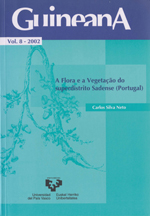Silva Neto, Carlos (2002). A Flora e a Vegetação do Superdistrito Sadense (Portugal)
##plugins.themes.bootstrap3.article.main##
##plugins.themes.bootstrap3.article.sidebar##
Published
27-03-2012
Carlos Silva Nieto
Abstract
This study was undertaken with a view to studying the flora and the vegetation of the litoral strip between Troia and Sines. This was done from a phytosociological perspective, cross-referenced with geomorphological, pedological and climatological studies carried out in order to understand the principal factors governing the distribuition of the floristic communities. In general, the vegetation in the area under study is influenced by a characteristic mediterranean climate with an antlantic influence and a lower thermomediterranean bioclimate, according to the classification of Rivas-Martinez (1996).
The flora and the vegetation of the study area have been arranjed in six broad biogeosystems which are characterized by the particular floristic communities and by the lito-morpho-pedological characteristics:
- beaches and coastal dunes under the influence of saliness
- dunes and inland sandy coverings
- conglomerate, gritty coastal cliffs
- surfaces made up Marateca formation sandistone and conglomerate
- peat-bogs
- marshy areas wihout peat soils
The flora of these six units is mostly mediterranean. However, various atlantic floral elements are to be found as a result of Quaternary climatic fluctuations. The originaliity of many of the floristics communities identified, resides in this suoerimposition of the atlantic and mediterranean species in the same territory. As a result of profound, ancient anthropic action, the floristic communities corresponding to the various simple types, are poorly represented and the substitution stages, damaged to a greater or lesser degree, make up the dominant vegetation.
The flora and the vegetation of the study area have been arranjed in six broad biogeosystems which are characterized by the particular floristic communities and by the lito-morpho-pedological characteristics:
- beaches and coastal dunes under the influence of saliness
- dunes and inland sandy coverings
- conglomerate, gritty coastal cliffs
- surfaces made up Marateca formation sandistone and conglomerate
- peat-bogs
- marshy areas wihout peat soils
The flora of these six units is mostly mediterranean. However, various atlantic floral elements are to be found as a result of Quaternary climatic fluctuations. The originaliity of many of the floristics communities identified, resides in this suoerimposition of the atlantic and mediterranean species in the same territory. As a result of profound, ancient anthropic action, the floristic communities corresponding to the various simple types, are poorly represented and the substitution stages, damaged to a greater or lesser degree, make up the dominant vegetation.
##plugins.themes.bootstrap3.article.details##
Section
Full Text

